Handling Deep Current for Big Smallmouth
How Jocumsen and Slegona do work on the St. Lawrence River
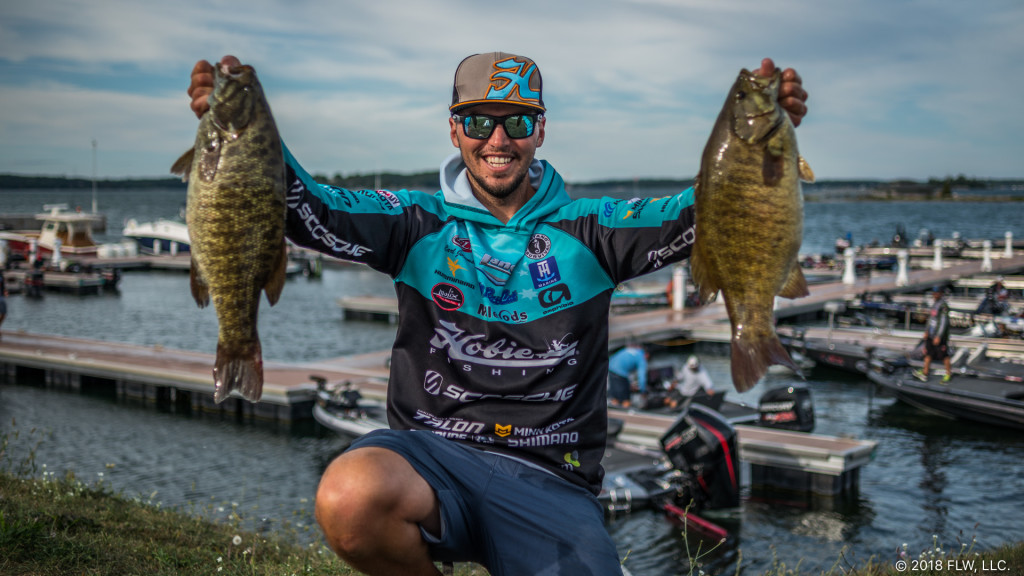
The St. Lawrence River offers nearly unparalleled smallmouth fishing, but it also presents a unique challenge. Bass anglers have fished in and around heavy current forever, though outside of the rest of the Great Lakes system, there isn’t a great comparison to the deep humps and eddies of the St. Lawrence. Carl Jocumsen and AJ Slegona both reaped the river’s bounty in the Costa FLW Series Northern Division season finale and have been perfecting river strategies for years. If you’re looking to improve your odds on the St. Lawrence — or anywhere with heavy current — you may want to take their advice.
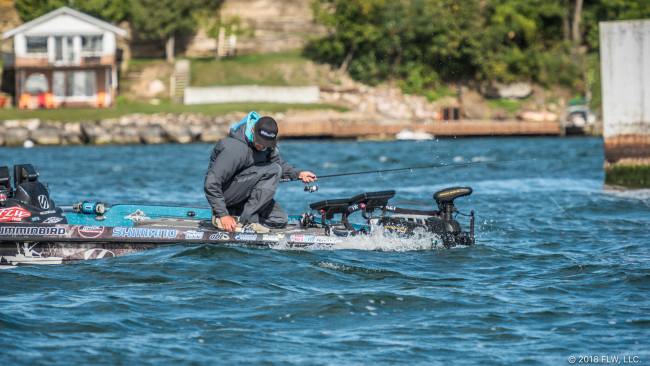
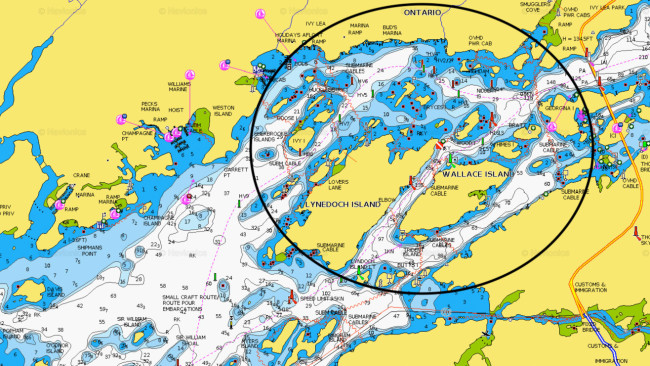
Don’t shy away from it
Though it is tempting to try to stay out of the current to do less work, Slegona and Jocumsen agree that the heavier current is usually better.
“Look for pinch points in the river, areas where the river bottlenecks down,” says Slegona. “You want to look for those real heavy current areas and cover that breaks current around there.”
Jocumsen saw the importance of good current firsthand over the course of a few weeks spent on the New York-Canadian border.
“The difference between this time and all the times I’ve gone there before is this time I looked for the heaviest current possible,” says Jocumsen. “Every single place I went, I wanted nothing to hinder it. I wanted as much current hitting that area as possible. The reason for that was because the water had dropped and the current had slowed.
“When I first got there, I noticed that I could hold on 60 on places where I had to have the trolling motor on 100 in years past. So, I realized that the current had dropped. Any place where it choked down and got skinny the current picked up. I think all of those big ones filtered into those choke points. They wanted that heavier current.”
Though you can certainly target the eddies and more slack areas near heavy current, fishing places that are right in the current can actually be more productive. Of course, fishing in current that’s constantly cooking along at two or three miles per hour requires some special tactics.
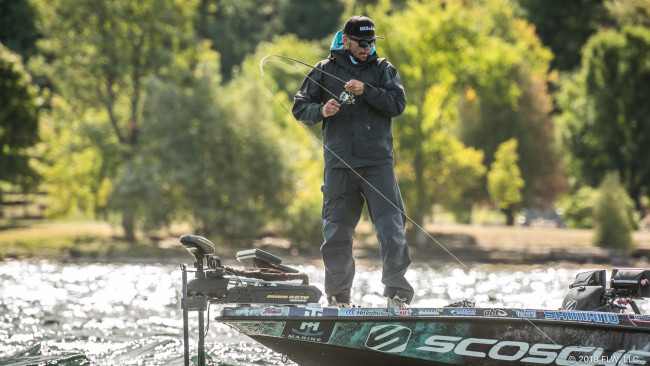
Work with the current
Much of the time (especially for longer areas), drifting with the current is the way to go on the St. Lawrence. To cover a hump or a series of humps involves starting on the up-current side, drifting over the top of the target area, and then cranking up to do it again. Of course, it’s not as simple as just pitching your bait out and letting the boat drift.
“As far as drifting goes, one of the biggest things is minimal bow in your line,” says Slegona. “When you’re fishing deep out there, you aren’t casting and bringing the bait to you ever. I’m always drifting. And you can’t drift with your line 20 feet out in front of you. It’s got to be as vertical as possible. That adds sensitivity and hookups, it corrects everything.”
Though Jocumsen doesn’t want the bait directly under the boat for stealth purposes, he agrees that a near vertical line is important. To maintain that, you need to follow the bait and the current with your boat, so “drifting” actually involves being on the trolling motor almost constantly to keep your presentation right.
“Slipping the current is not as easy as going up and just killing the motor and drifting. The whole time I was manipulating the trolling motor to keep in prime position and at the prime speed,” says Jocumsen. “With just the water flow you would go about two to two-and-a-half miles per hour, and you wouldn’t get bit the whole time. I figured out that .9 or 1.2 miles per hour was what they wanted. You needed to stay close to your bait so it was almost a vertical line, and keep pulling your bait along or slowing it up so it would drift right.”
A good drift is a game of constant adjustments – you aren’t locked into any one depth or spot.
“You had to be careful to not actually get too precise. When you get on a good drift the depths are changing the whole time,” says Jocumsen. “When I came over a hump I would let line out to keep it down so it wasn’t just suspending through the water. I would open my bail and give it like one rod length, and when I would do that I would drive the boat up towards the bait because I never wanted to get too much of an angle on the line.”
On days one and two of the Costa FLW Series at the 1000 Islands, Jocumsen was actively slowing his bait down, essentially dragging it slightly against the current to maintain his ideal speed. On the final day, faced with a strong east wind, he had to do the opposite, constantly driving his boat into the wind kept his bait moving at the key speed below the water. By the end of the final day, he was chasing the bait with his trolling motor on 7.
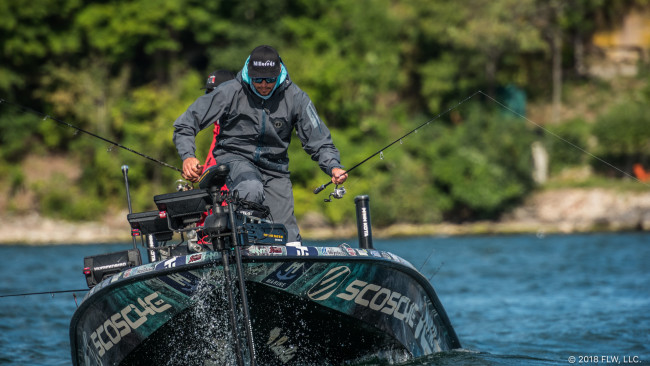
A short-term option
One tidbit that Jocumsen figured out this year at the St. Lawrence was that some of the bigger bass were sitting directly on the up-current side of humps. He broke with convention to target them.
“I wanted to fish this small hump — it was maybe only 50 yards wide — and I tried to run up and drift it, but the drift lasted 10 seconds. You just zipped over it and it was done. It wasn’t very efficient,” says Jocumsen. “So the next time, when I came over the hump, right when I got past what I thought was the bite window, I hit SpotLock. The trolling motor was on 100 trying to hold me in that one area, and I just cast up to the deep side, kept a tight line and let the current bring it up those rocks. Then I could bring my bait through there 30 times in 10 minutes, rather than having to drive up.”
Jocumsen was skeptical until about his fifth cast when he caught a 5-pounder. Essentially, trout fishing with a drop-shot, a Minn Kota Ultrex and SpotLock make it possible, but you still can’t do it all day.
“You have to know you’re going to get bites though,” says Jocumsen. “You can probably only do it for maybe half the day before your batteries are going to be toast. You sit there for 20 minutes with the trolling motor on 100, and it won’t last all day. You have to do it while they’re there and biting.”
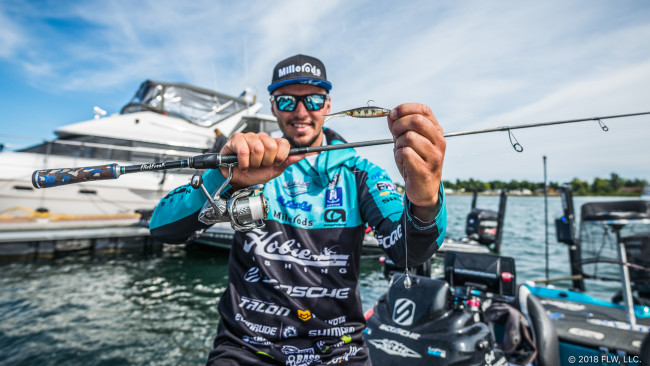
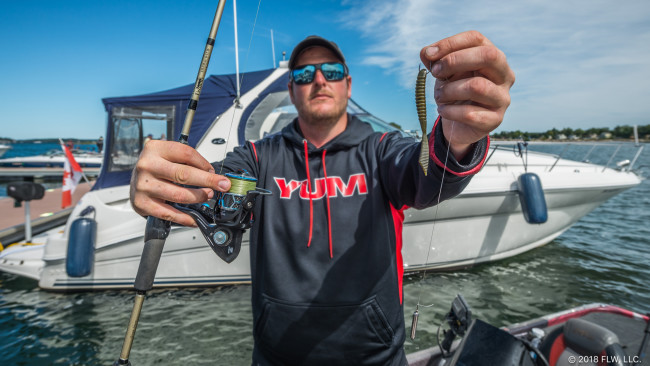
The right equipment
Feeling and fighting big smallmouths in big current puts a lot of strain on the tackle involved. Both Jocumsen and Slegona say that sensitivity is paramount, and they rig up with that in mind. Slegona uses 10-pound test Vicious No-Fade Braid with an 8-pound-test Vicious Pro Elite Fluorocarbon leader. His rod is a 7-3, medium-power Fitzgerald All Purpose Series and his reel of choice is an Ardent Bolt.
Jocumsen likes and even lighter setup, rolling with 6-pound-test fluorocarbon and a 6-pound-test mainline. His rod and reel combo is a 6-10, medium-light Millerods FlickFreaK matched up with a Shimano Stella.
Your preference may vary, but the important part is to do everything you can to maintain sensitivity. From boat positing in relation to the bait to the tackle you use, it matters. Jocumsen says he caught perhaps 100 smallmouths on day two of the 1000 Islands event and his co-angler didn’t manage a limit. He believes a lot of that has to do with the overall sensitivity of his program – whenever a smallmouth mouthed his bait, Jocumsen converted.
Both pros primarily utilize a drop-shot on the St. Lawrence, but a tube and a Ned rig will occasionally get the call as well. For the drop-shot, Slegona likes a YUM Warning Shot or a goby bait most of the time. The winner of the 1000 Islands event, Kyle Hall, used a Berkley MaxScent Flatnose Minnow, and you might do well to consider something in the MaxScent or Gulp! line as well, because smallmouths really seem to love them.
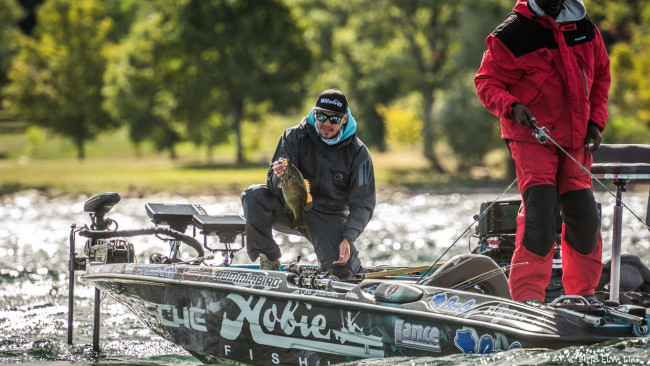
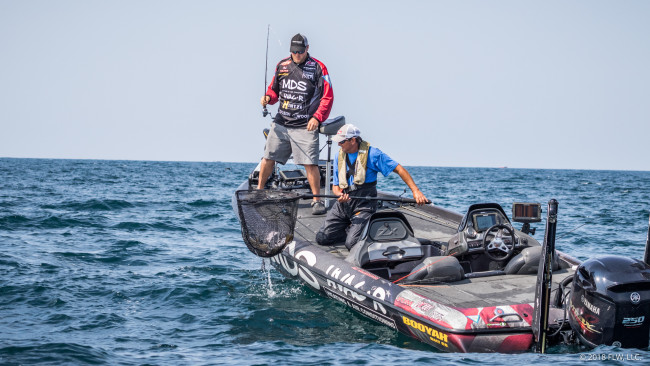
Tournament tips
Finding and catching fish efficiently is paramount in tournaments when time is limited. Unfortunately, because of the nature of smallmouths and the heavy current, you can’t make use of your electronics quite as well as you can on places like the Tennessee River.
“I’d say most of the time, when I scan over a shoal out there, I won’t see anything on it,” says Slegona. “You have to fish it to figure out if there are any [fish] there or not. Usually, if you hook one fish, that’s when you’ll see what is truly there. They’ll all rise off the bottom. Smallmouth-wise, if I don’t see a fish, I’m fishing it regardless.”
One area in which you can get an edge is with your fluorocarbon leader. Slegona uses a 15-foot leader, and Jocumsen goes really long too. When you’re dealing with rugged conditions and lots of zebra mussels, your line can take a beating, but it’s the quantity of smallmouths that really can put the hurt on your leader. Re-tying a leader on the water is a major waste of time, so the longer you go with the leader, the better it is for efficiency purposes.
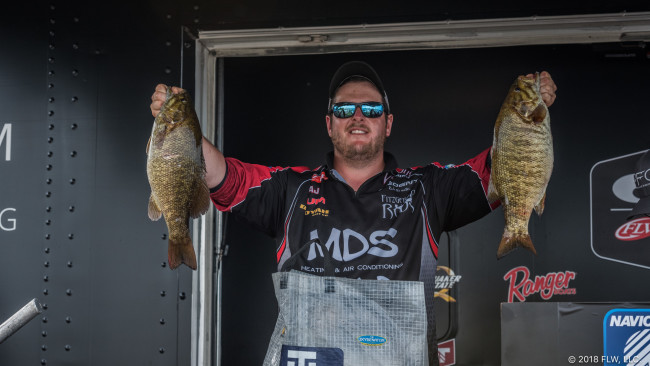
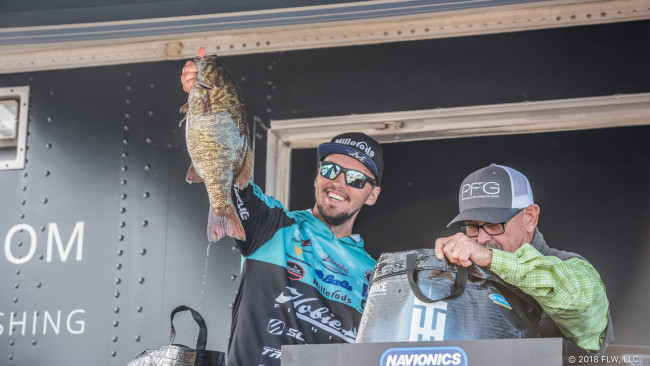
Get after it
If you get the chance to fish around the 1000 Islands, you absolutely have to take it. The fishery is simply too good to pass up. When you do go, be prepared to do some work. Sloppy presentations are a big waste of time, but if you take Slegona’s and Jocumsen’s advice and get around current (and fish), you should have success.